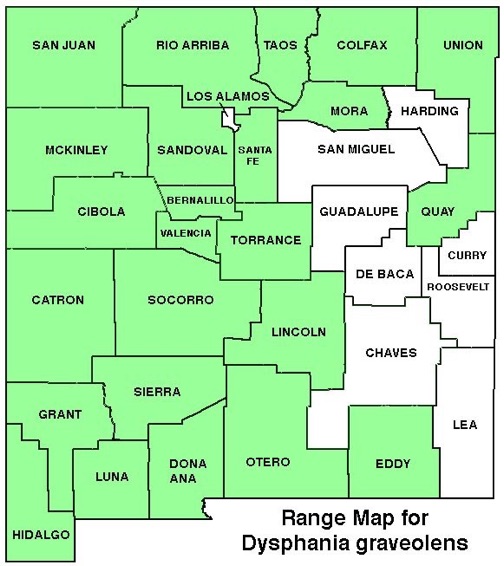WILDFLOWERS OF NEW MEXICO

Erect, leafy stems of this aromatic herb reach 2 feet tall and form dense colonies in shaded openings of pine forests. Note the deeply cut leaves with pointed lobes, and the insignificant yellowish-green flower clusters in the leaf axils. The stem and branches turn bright red in the fall, often covering the forest floor with a blanket of vibrant color.
FLOWER: August–September. Small, tight clusters of inconspicuous yellowish-green flowers in leaf and branch axils; petals absent.
LEAVES: Alternate. Blades lance-shaped to elliptic, 5/8–1 1/2 inches long (1.5–4 cm); margins deeply cut with pointed lobes with or without teeth; aromatic with yellow glands on the lower surface.
HABITAT: Sandy, rocky, loamy soils of open woodlands, mountain grasslands, meadows, and shrublands, disturbed areas; pinyon-juniper-oak, ponderosa-Douglas fir woodlands.
ELEVATION: 5,000–10,200 feet.
RANGE: AZ, CO, NM TX, UT.
SIMILAR SPECIES: Two introduced species widespread in NM: Epazote, D. ambrosiodes, from Mexico, has small, spiked flower clusters, and slender, entire to toothed (not lobed) leaves; Jerusalem-oak, D. botrys, from the Mediterranean, has oak-like, wavy- lobed leaves, and dense terminal flower clusters 4 3/4–9 1/2 inches long.
NM COUNTIES: Widespread in NM mountains from mid- to high-elevation habitats: Bernalillo, Catron, Cibola, Colfax, Dona Ana, Eddy, Grant, Hidalgo, Lincoln, Luna, McKinley, Mora, Otero, Quay, Rio Arriba, San Juan, San Miguel, Sandoval, Santa Fe, Sierra, Socorro, Taos, Torrance, Union, Valencia.

FETID GOOSEFOOT
DYSPHANIA GRAVEOLENS
Amaranth Family, Amaranthaceae (formerly Chenopodiaceae)
Annual herb


THE CONTENTS OF THIS WEBSITE ARE COPYRIGHTED AND CANNOT BE USED
WITHOUT PERMISSION OF GEORGE OXFORD MILLER
EMAIL ME




Tiny flowers grow in small clusters in the leaf and branch axils.

Leaves are pinnately cut into pointed lobes.
Stems and branches turn bright red in the fall.
Fetid goosefoot can form dense stands in open pine woodlands.
